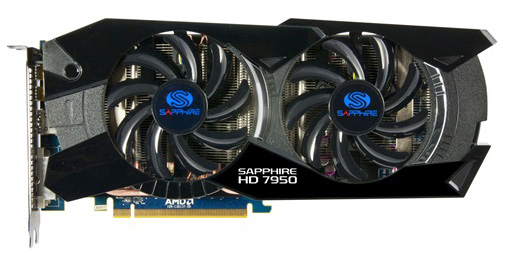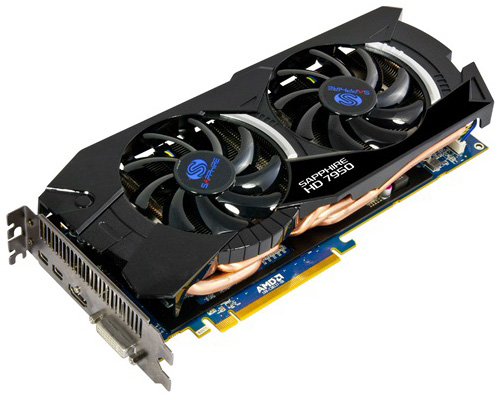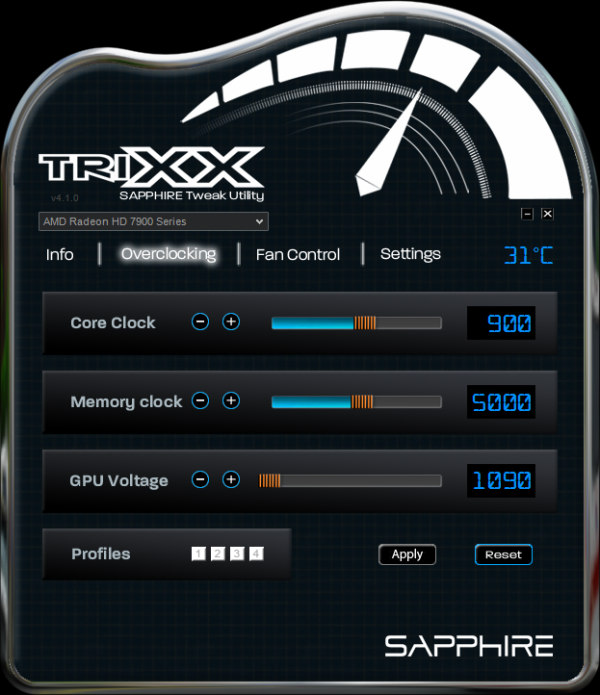AMD Radeon HD 7950 Review Feat. Sapphire & XFX: Sewing Up The High-End Market
by Ryan Smith on January 31, 2012 9:02 AM ESTMeet the Sapphire HD 7950 Overclock Edition
Since our reference 7950s are built on the 7970 PCB and cooler, we’re going to jump right into our vendor cards starting with the Sapphire HD 7950 Overclock Edition.
As with all of the 7950 cards launching today, Sapphire’s HD 7950 Overclock Edition uses the AMD 7950 PCB. This is a slightly shorter PCB measuring 10.25” long, saving .25” over the 7970 PCB by eliminating a few components that the lower board power of the 7950 makes unnecessary. The PCB is otherwise very similar to the 7970 PCB, utilizing 12 GDDR5 memory chips organized around the Tahiti GPU, while at the top you’ll find the 2 CrossFire connectors, a pair of 6pin PCIe power sockets, and the BIOS selection switch. The latter will be of particular interest to unlockers, as the switch should make it possible to safely attempt to unlock the 7950 into a 7970.

Moving on, as this is a semi-custom card the real differentiation is in the factory overclock and the cooler. On the performance side of things Sapphire will be shipping the 7950 Overclock Edition at 900MHz core and 5GHz memory, representing a 100MHz (12.5%) core overclock and no change on the memory clock.
Meanwhile for the cooler Sapphire is using what they’re calling the Dual-X cooler. The Dual-X is yet another double-wide dual-fan open air cooler, with 2 fans providing copious airflow over an aluminum heatsink running virtually the entire length of the card. Sapphire’s fan cutouts are just a bit bigger than most other dual-fan coolers and placed a bit higher, and as a result the Dual-X cooler is a bit taller than the PCB by about 15mm at its highest point. Meanwhile the cooler is also a fair bit longer than the PCB, putting the total card length at 11”.
Moving below the fans and the heatsink we’ll find the heatpipe assembly, which is responsible for carrying heat from the GPU to the heatsink. The Dual-X uses 5 copper heatpipes of varying radius that run from one end of the heatsink to the other. The 5 heatpipes converge at the base of the assembly, where a copper baseplate provides contact with the GPU. Meanwhile cooling for the VRM MOSFETs and RAM is provided by a black aluminum plate, which is placed over those components with heat transfer provided by the use of thermal pads. There is no connection between the plate and the heatsink, so the only heat dissipation from the plate is provided by whatever airflow from the fans reaches the plate.

At the front of the card we’ll find the display ports, which as this is an AMD PCB the card utilizes the standard AMD 7000 series port configuration of 1 DL-DVI port, 1 HDMI port, and 2 mini-DisplayPorts. Filling out the second slot is the grating for ventilation, though even with the ventilation slot the usual precautions for an open-air cooler apply: you’ll need a case with enough airflow to handle the roughly 200W of heat the card is capable of dumping inside of your case.
Rounding out the package is the usual collection of dongles and materials. Sapphire includes 2 molex-to-6pin PCIe adaptors, an HDMI to DVI dongle, a miniDP to DisplayPort dongle, a DVI to VGA dongle, and a 1.8m HDMI cable. Along with the dongles Sapphire packs a quick start guide and a driver installation CD.
The only thing you won’t find packed in the box is TriXX, Sapphire’s in-house overclocking utility. TriXX has been around since the 6900 series, but as this is the first high-end Sapphire card we’ve reviewed since it was released, this is the first time we’ve had it available for a review.
Fundamentally TriXX is a fairly well designed, albeit barebones overclocking utility. Along with an info readout similar to GPU-Z, TriXX provides overclocking and fan control support for Sapphire’s cards, including support for custom fan profiles and more importantly voltage control. With TriXX it’s possible to overvolt most of Sapphire’s performance and high-end cards, and as Sapphire uses AMD reference PCBs it also works with any other cards using AMD’s PCBs.
Beyond these features there’s little more to TriXX. It’s not an all-encompassing video card utility like MSI’s Afterburner, which means it comes up short if you need more functionality but it's exactly what you need if you just want to overclock. To that end it’s a clear step up compared to most other manufacturer’s poorly designed utilities, and from a design perspective its only real sin is the hard to read blue-on-black text. Otherwise it’s a competent overclocking utility that does exactly what it’s supposed to and provides voltage control for those who need it.
Finally, Sapphire will be selling the 7950 OE for $479, $30 over the baseline 7950 MSRP. Meanwhile the warranty on their card is their standard 2 year warranty.















259 Comments
View All Comments
Prosthetic Head - Friday, February 3, 2012 - link
I purchased a second hand 4850 and put a nice custom cooler on it about 3.5 years ago. It runs near silent and performs more than adequately in all the games I play. I honestly don't see the excitement in GPU announcements unless they really are game changers (59XX, 9800XT --> 6800, X800 type leaps). I realise I'm not a bleeding edge gamer & some of you are and thats great - It means second hand high end GPUs available regularly for the same price as low end offerings less than a year later.The only thing that tempts me about the new architectures is the compute performance. I actually use this for some computational chemistry work and the upgrade looks well worth it if I do more of this type of work.
The improving performance / power ratio is also of interest since I don't like loud fans, hot computers or excessive electricity consumption.
Galidou - Saturday, February 4, 2012 - link
Don't worry, chizow is a fanboy, there's nothing to do against greenies, they have a closed mind :PHe never said anything wrong about nvidia but sure has a ton of things to say about AMD. He speaks of overclockability of GTX 580, get an answer about how overclockable the 7970 and then changes his mind and says he cares about OC but not much about stock cards OC(which the 7970 seems to do VERY well).
Makes no sense when you say things and then right after what you say has no value for the other team.....
chizow - Saturday, February 4, 2012 - link
No, I said it makes no sense to compare one stock part to one that's overclocked. If you want to compare apples to apples, you overclock both, I have no problem with that and I think you'll find that both parts overclock similarly so the original difference in stock performance holds true.Only a fanboy would try to compare stock to OC results as you and others apparently tried to do.
Galidou - Sunday, February 5, 2012 - link
I never tried to compare any video card, I'm a proud owner of both camps video card, from geforce 2 gts all the way up to 6850 in crossfire and gtx 560 ti in other rig... thing is you never said anything wrong about Nvidia and I can say wrong things and good things about both camps being an owner of MULTIPLE of their cards...Someone with only one side of a story shouldn't be used as a reference for righteousness in judgement... Like taking a judge for an affair of murder while the judge himself is in the family of the murdered one.....
Anyway just my two cents...
chizow - Sunday, February 5, 2012 - link
If you never tried to compare any video card, why are you defending someone who did then?As usual with these kinds of threads arguing with ignorant fanboys, I'm simply keeping things honest and correcting erroneous flaws in facts or logic.
Does it make sense to you to make a comparison about one overclocked part compared to another stock part, then declare the OC'd part the winner based on those results?
Of course not!
As for your two cents, keep them, you will need to save every penny to make the jump from 6850 or GTX 560ti to 7950s at these prices.
Galidou - Sunday, February 5, 2012 - link
There was bad things about AMD and Nvidia in history and thing is you can only mention bad things from one side. I'd never listen to someone that already has a choosen side to speak about ANYTHING in my whole life, simply because you won't be able to hear the absolute truth from the defender of only one side...chizow - Saturday, February 4, 2012 - link
No, but you were talking about me. So, please explain what you think determines pricing in this market since you insist I have no clue, or YOU shut up.Thanks!
chizow - Saturday, February 4, 2012 - link
Yes of course, because it would be negligent not to from any perspective.Anyone who buys something at any point needs to project the market, needs to weigh the potential for obsolescence. That's a large reason why companies do NOT disclose unannounced products as not to erode their own sales before a product goes EOL.
Similarly, it would be negligent if AMD didn't project Nvidia's next-gen parts given they use the same fab and process. And right now, AMD is basically telling you with this price that they either 1) are ignoring Nvidia's 28nm partsor 2) think Nvidia's 28nm parts perform the same as their 40nm parts or 3) don't think their customers are smart enough to realize 1 or 2.
Either way, they're going to look the fool once Nvidia does release their 40nm parts.
chizow - Saturday, February 4, 2012 - link
You mean the super-OC'd Classified 3GB versions that perform within a few % points of the 7970? Yeah of course there are. You'd be a moron not to realize the difference, or you're just being dishonest. With you it could be either.Most 580s are in the same price range as the 7950, $440-500, because once again, they deserved that price tag when they launched 14 months ago and the release of the 7950 has done nothing to make Nvidia drop the price on them.
But as I said, this price and performance level will be retired soon, but obviously not as a result of the "next-gen" Tahiti parts. We'll most likely have to wait for the real "next-gen" parts with Kepler to shift this stagnant price:performance metric.
chizow - Saturday, February 4, 2012 - link
No, only a moron would blow $500 on another card a year later that performs the *SAME* as the card they paid $500 for a year earlier. And that's why the 7950's pricing sucks.There's light at the end of the tunnel, you may finally be getting it lol.